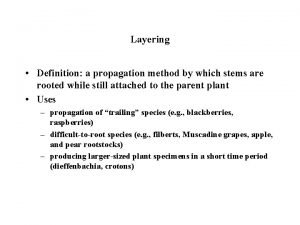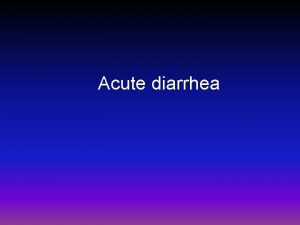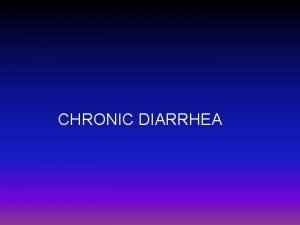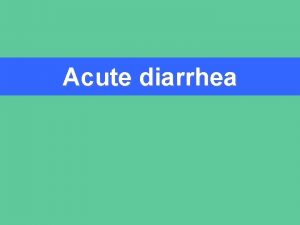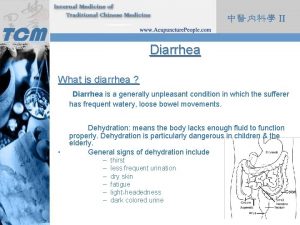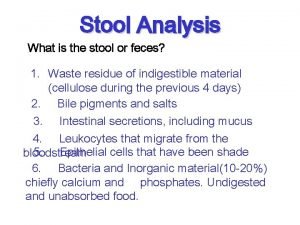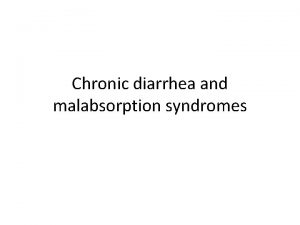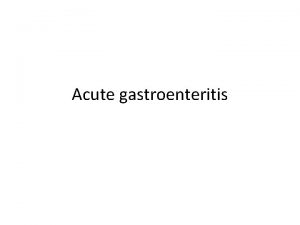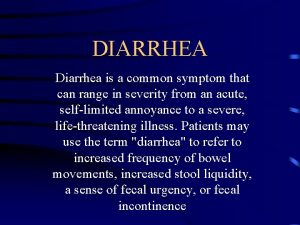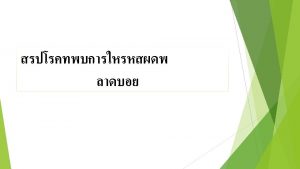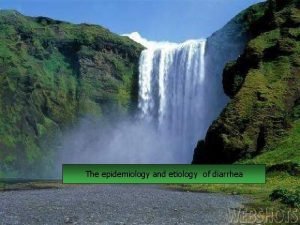Diarrhea Diarrhea Definition Stool that contains more water















- Slides: 15

Diarrhea

Diarrhea Definition: Stool that contains more water than normal

Leading cause of death in developing Countries. 3. 2 million deaths/Year in those <5 y of age, with average 3. 3 episodes of Diarrhea/year, may reach to 9/year. In some areas, death mostly occurs in the 1 st 2 years of life (80%), the main causes are: dehydration, malnutrition & serious infection. Diarrhea represents an economic burden on the developing countries which includes bedoccupancy (about 1/3 of hospital beds in some countries occupied by patients with Diarrhea), also I. V. fluid (expensive), Rx. & ineffective drugs

Types of Diarrhea: - Acute watery: <14 days, some times associated with vomiting. - Dysentery: diarrhea + visible blood in the faces associated with rapid weight loss due to anorexia. - Persistent Diarrhea: >14 days, episodes of watery Diarrhea or dysentery associated with dehydration & malnutrition. - Chronic Diarrhea: is not due to infection but chronic diseases (crohn`s, coeliac, . . ) so it is not included here.

Epidemiology: Transmission is promoted by specific behaviors: 1 Failing to breast–feed exclusively for the 1 st 4 -6 months of life. 2. Using infant feeding bottles. 3. Storing cooked food at room temperature. 4. Using drinking water contaminated with fecal bacteria. 5. Failing to wash hands after defecation, disposing of feces, or before handling food.

Etiology: According to prevalence: Rota Virus ETEC enterotoxigenic E-coli. Shigella. Campylobacter jejuni. E. histolytica. V. cholerae Cryptosporidi Salmonella

Causes of Malnutrition in diarrhea 1. Reduced food intake due to: - - Anorexia (especially in dysentery) - Vomiting: with a low discourage attempts at feeding. - Withholding of food : based on traditional believes about Rx. Of D. (Rest the bowel). - Giving food with reduced nutrient value: gruel, soup in the believe that a diluted food is easier to digest.

2. Decreased absorption of nutrients: - Damage to the absorptive (villous) epithelial cells. - Disaccharide’s deficiency owing to impaired production of enzyme by the damage villous (may lead to mal-absorption of disaccharide sugar especially lactose) - Reduced internal concentration of bile acids that affects the fat absorption. - Rapid transit of food through the GIT, leaving an insufficient time for digestion and absorption

3. Increased nutrition requirements due to: - Metabolic demands with fever - Damaged appetite -The need to replace serum protein lost through the damaged mucosa as in dysentery.

Prevention of Diarrhea: Ø Ø Ø Giving only breast milk for the first 4 -6 months of life (Exclusive BF). Avoiding the use of infant feeding bottles. Improving practices related to the preparation & storage of weaning food to decrease contamination Using clean water for drinking. Washing hands (after defecation/disposing feces & before eating or preparing food. Safe disposing of feces including those of infants (its risky, contaminated & not sterile as misbelieved).

Measures that strengthen the defense : 1. Continue to breastfeed for at least 2 years of life. 2. Improving nutritional status by improving nutritive value & increase amount of weaning food. 3. Immunization against measles.

Control of Diarrheal Diseases CDD

I- Assessment General Well, alert Irritable, * condition restless Normal Sunken Eye Dry Lethargic, * unconscious Very sunken Mouth Moist Very dry Thirst Tears Not thirsty Drinks * Eagerly Present Absent Pinched Skin Goes back* Very slowly * quickly slowly Can not * drink Absent

No dehydration some dehyd. Severe dehyd. At home PHC (ORS) Hospital (I. V. ) if<2 y. Keep on BF if>2 y. give much fluid preferably salty Increase food intake (Not roughage, not diluted, not sweat)add 1 spoon oil 100 -200 ml ORS or fluid after each loose motion according to age teach the mother how to prepare& administer consult after 3 days if: -doesn’t get better -vomiting -increase diarrhea -fever Wt. * 70 in the 1 st 4 hr. then assess & behave accordingly Wt. * 100 1/3 during 1/2 hr. 2/3 during 2 hrs. +ORS then assess

• • • If there is fever think of malaria if the area is endemic If there is fever & blood think of shigellosis If the stools are watery look for cholera in the area If there is blood with stool dysentery) & Rx. shigellosis failed then think of parasite (Amoebiasis) If diarrhea lasted > 14 days think of Giardiasis Never give antibiotics apart from these conditions • Never give anti-diarrhea, anti-spasmodic, or anti-emetic Why CDD? To decrease morbidity & mortality in an easy, rapid way with less facilities & with the participation of all health workers at different levels & also the family.
 More more more i want more more more more we praise you
More more more i want more more more more we praise you More more more i want more more more more we praise you
More more more i want more more more more we praise you Water and water and water water
Water and water and water water Phân độ lown
Phân độ lown Block xoang nhĩ ecg
Block xoang nhĩ ecg Thể thơ truyền thống
Thể thơ truyền thống Thơ thất ngôn tứ tuyệt đường luật
Thơ thất ngôn tứ tuyệt đường luật Chiến lược kinh doanh quốc tế của walmart
Chiến lược kinh doanh quốc tế của walmart Tìm vết của mặt phẳng
Tìm vết của mặt phẳng Hãy nói thật ít để làm được nhiều
Hãy nói thật ít để làm được nhiều Tôn thất thuyết là ai
Tôn thất thuyết là ai Gây tê cơ vuông thắt lưng
Gây tê cơ vuông thắt lưng Sau thất bại ở hồ điển triệt
Sau thất bại ở hồ điển triệt A building that contains one or more telescopes
A building that contains one or more telescopes Layering plants meaning
Layering plants meaning Environmental science chapter 11
Environmental science chapter 11














